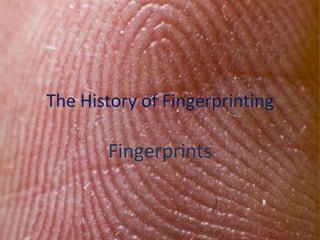
History of fingerprinting
- 1. The History of Fingerprinting Fingerprints
- 2. • Since the beginnings of criminal investigation, police have sought an infallible means of human identification. The first systematic attempt at personal identification was devised and introduced by a French police expert, Alphonse Bertillon, in 1883. The Bertillon system relied on a detailed description (portrait parlé) of the subject, combined with full-length and profile photographs and a system of precise body measurements known as anthropometry.
- 3. Alphonse Bertillon 1853-1914 The use of anthropometry as a method of identification rested on the premise that the dimensions of the human bone system remained fixed from age 20 until death. Skeleton sizes were thought to be so extremely diverse that no two individuals could have exactly the same measurements.
- 4. • For two decades, this system was considered the most accurate method of identification, but in the early years of the 20th century, police began to appreciate and accept a system of identification based on the classification of finger ridge patterns known as fingerprints. Today, the fingerprint is the pillar of modern criminal investigation.
- 5. The Early Use of Fingerprinting • The Chinese used fingerprints to sign legal documents as far back as three thousand years ago. Whether this practice was performed for ceremonial custom or as a means of personal identity remains a point of conjecture lost to history. In any case, the examples of fingerprinting in ancient history are ambiguous, and the few that exist did not contribute to the development of fingerprinting techniques as we know them today.
- 6. The Early Use of Fingerprinting • Sir William Hershel: Several years before Bertillon began work on his system, William Herschel, and English civil servant stationed in India, started requiring natives to sign contracts with the imprint of their right hand, which was pressed against a stamp pad for the purpose. The motives for Herschel’s requirement remain unclear; he may have envisioned fingerprinting as a means of personal identification or just as a form of the Hindu custom that a trace of bodily contact was more binding than a signature on a contract. In any case, he did not publish anything about his activities until after a Scottish physician, Henry Fauld, working in a hospital in Japan, published his views on the potential application of fingerprinting to personal identification.
- 7. The Early Use of Fingerprinting • Henry Fauld: In 1880 Fauld suggested that skin ridge patterns could be important for the identification of criminals. He told about a thief who left his fingerprint on a whitewashed wall, and how in comparing these prints with those of a suspect, he found that they were quite different. A few days later, another suspect was found whose fingerprints compared with those on the wall. When confronted with this evidence, the individual confessed to the crime.
- 8. • Fauld was convinced that fingerprints furnished infallible proof of identification. He even offered to set up at his own expense a fingerprint bureau at Scotland Yard to test the practicality of the method. But his offered was rejected in favor of the Bertillon System. This decision was reversed less than two decades later.
- 9. Early Classification of Fingerprints • Extensive research into fingerprinting conducted by Sir Francis Galton provided the needed impetus that made police agencies aware of its potential application. In 1892, Galton published his classic textbook Finger Prints, the first book of its kind on the subject. In his book, Galton discussed the anatomy of fingerprints and suggested methods for recording them.
- 10. Early Classification of Fingerprints • Galton also proposed assigning fingerprints to three pattern types – loops, arches, and whorls. Most important, the book demonstrated that no two prints are identical and that an individual’s prints remain unchanged from year to year. At Galton’s insistence, the British government adopted fingerprinting as a supplement to the Bertillon system.
- 11. Early Classification of Fingerprints • The next step in the development of fingerprint technology was the creation of classifications systems capable of filing thousands of prints in a logical and searchable sequence. Dr. Juan Vucetich, a police officer from Argentina who was fascinated by Galton’s work, devised a workable concept in 1891. His classification system has been refined over the years and is still widely used today in most Spanish-speaking countries.
- 12. • In 1897, another classification system was proposed by an Englishman, Sir Edward Richard Henry. Four years later, Henry’s system was adopted by Scotland Yard. Today, most English-speaking countries, including the United States, use some version of Henry’s classification system to file fingerprints.
- 13. • Early in the 20th century, Bertillon’s measurement system began to fall into disfavor. Its results were highly susceptible to error, particularly when the measurements were taken by people who were not thoroughly trained. The method was dealt its most severe and notable setback in 1903 when a convict, Will West, arrived at Fort Leavenworth prison. A routine check of the prison files startlingly revealed that a William West, already in the prison, could not be distinguished from the new prisoner by body measurements or even by photographs. In fact, the two men looked just like twins, and their measurements were practically the same. Subsequently, fingerprints of the prisoners clearly distinguished them.
- 14. • In the United States, the first systematic and official use of fingerprints for personal identification was adopted by the New York City Civil Service Commission in 1901. The method was used for certifying all civil service applications. Several American police officials received instruction in fingerprint identification at the 1904 World’s Fair in St. Louis, Missouri from representatives from Scotland Yard.
